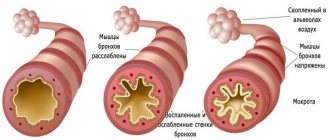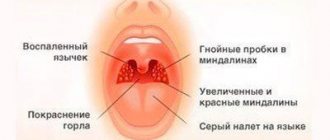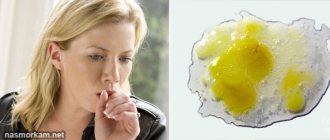Infectious causes
The question of why mucus accumulates in the throat is asked by many patients who have a similar symptom? The process of producing viscous secretion itself is natural.
If there is always too much mucus in the throat, this indicates that the process of secretion formation is disrupted.
This is often due to infectious factors.
The causative agents of the inflammatory process can be various fungi, viruses and microbes, they are:
- sinusitis - characterized by an inflammatory process in the paranasal sinuses, accompanied by excessive mucus secretion from the nasal canal,
- tonsillitis - affects one or more tonsils, and during expectoration the mucus has a characteristic green color,
- adenoiditis - inflammation of the adenoids, accompanied by the growth of the nasopharyngeal tonsil as a result of mucus collecting in the throat,
- bronchitis is a common disease that disrupts the drainage function of the lungs; pathological secretions begin to accumulate in the pharynx,
- tracheitis - inflammation of the trachea, manifested in hyperactivity of mucous epithelial cells, causing the formation of viscous sputum in the throat,
- pharyngitis is a lesion of the lymphoid tissues of the pharynx, causing the accumulation of mucus in the respiratory tract.
Mucus discharge in large volumes can be one of the symptoms of pneumonia and other serious diseases of the lungs and respiratory tract.
Non-infectious causes
The appearance of mucus in the throat can also be caused by other reasons. These include:
- allergic rhinitis,
- mucous membrane injuries,
- gastroesophageal reflex,
- frequent consumption of spicy foods,
- smoking.
Both phlegm in the throat without a cough and with a cough can be caused by external irritants. Smoking forces our body to “defend itself” - to produce even more mucus so that the mucous membrane is not injured. In addition to smoking, frequent consumption of alcohol or carbonated drinks can be causes of phlegm in the throat without a cough. Usually phlegm begins to collect in the morning, causing discomfort.
Considering that the esophagus is closely connected to the throat, the accumulation of mucus in the throat is caused by gastrointestinal diseases. Gastritis, pancreatitis and other ailments provoke the formation of mucus immediately after eating.
Mucus in the throat accumulates along with other symptoms of illness, such as belching and heartburn. This is one of the reasons why people suffering from gastrointestinal problems need to follow special nutritional rules. If your throat starts to feel sore after eating, this is also a sign that you need to check the functioning of your digestive system.
Severe symptoms
Symptoms bring a lot of inconvenience to both adults and children:
- a feeling of the presence of a foreign body in the throat, which is called a “lump in the throat”,
- incessant tingling, burning,
- constant desire to cough,
- pain when swallowing food, especially solid foods,
- nasal congestion,
- bad breath,
- headaches, deterioration of health.
These and other symptoms interfere with the normal functioning of a person. Doctors recommend paying attention to the color of sputum when expectorating.
If the mucus in the throat is light, almost transparent, then the fight against it must be started immediately so that the symptoms do not worsen. If it is dark, then this is already a sign of accumulation of pus. In some cases, red blood cells accumulate in the throat, and then when coughing up, blood clots are noticeable.
This is a sign that you need to see a doctor to use diagnostics and tests to determine the causes and treatment.
How to treat snot in the throat
Often with pharyngitis, adenoids, rhinosinusitis, and after a cold, mucus accumulates in the throat. The degree and severity of the disease does not depend on the cause; rather, they are determined by the neglect of the process. Accumulated snot in the throat causes a lot of inconvenience:
- feeling of a lump in the throat;
- provoked cough;
- constant sensation and swallowing of mucus;
- the appearance of a runny nose;
- discomfort while talking and eating;
- bad breath if there is a bacterial infection.
Why do they appear?
Regardless of the cause, the mechanism of mucus accumulation is the same. Snot gets into the throat if there is an inflammatory process in the mucous membrane of the pharynx, nose or paranasal sinuses. Mucus draining from the nasal passages is retained if the mucous membrane of the back wall of the pharynx is inflamed.
The cilia of the inflamed mucosa are unable to promote mucus, and the secreted secretion is not enough to dilute the sputum. The situation gets worse if a person with a runny nose constantly uses vasoconstrictor nasal drops.
A slight accumulation of mucus in the nasopharynx can occur in smokers, after drinking alcohol, acidic foods, sucking pastilles and lollipops.
How to get rid
In the treatment of a thick runny nose, it is important to observe two points - moisturize the throat and treat it with antiseptics; if necessary, you need to add an antibacterial agent. Usually, snot in the throat accumulates after sleep in the morning. A good expectorant push and a mug of hot drink may be enough to remove the lump in the throat.
Sometimes it is necessary to thoroughly rinse your throat and nose with saline solution. Before using any medicinal product, you must carefully read the indications, contraindications, special instructions and method of use indicated in the instructions for use.
Inhalations
Inhalations will help you quickly get rid of mucus, because the inhaled vapors reach their destination immediately. For inhalation, it is recommended to use a warm saline solution with soda, a decoction of coltsfoot leaves, sage herb, oak bark, and eucalyptus leaves.
The saline solution thins the mucus and helps it separate from the walls of the mucous membrane. Do not inhale at elevated body temperatures.
After inhalation, you need to blow your nose well and carefully cough up phlegm from your throat. If you drink warm herbal tea with honey, the positive effect will come faster.
Expectorants
An important point is the use of expectorants - they thin the mucus and help it separate from the walls of the mucous membrane. As a result, all the mucus comes out naturally with a cough. For the treatment of adults, you can use cough tablets, Ambroxol, Bromhexine, Libexin, Mucaltin, Lazolvan.
A faster and more effective drug is ACC, Acetsex. Cough and snot in a child’s throat are best treated with herbal expectorants - cough syrups Gedelix, Gelisal, Linkas. There is no need to drink an expectorant for a long time; 1-2 days are enough until the phlegm comes out.
Rinse your throat
Rinsing not only removes snot mechanically, it moisturizes the mucous membrane, relieves inflammation, the active components of solutions and decoctions normalize mucus production and kill bacteria.
For a thick runny nose, you can rinse with a saline solution, adding one teaspoon of salt, soda and 10 drops of iodine to a glass of water; decoctions of medicinal herbs are suitable for rinsing.
You can use a pale pink solution of potassium permanganate, a solution of furatsilin.
You need to rinse your throat constantly, the more often the better. If the child does not know how to gargle through the mouth, the solution should be dripped into the nose so that it flows down the back wall of the throat.
Antiseptics and anti-inflammatory
They help not only remove accumulated mucus, but also relieve sore throat, inflammation and sore throat, relieve swelling and inflammation. You can use any pharmacy spray, but Lugol, Ingalipt, Larinal are preferable. If the cause of the disease is pharyngitis, then you can treat your throat with Orasept. The throat is treated 2-3 times a day - you need to open your mouth wide and spray the spray 2-3 times.
Nasal drops
Astringent nasal drops Collargol, Protargol, Sialor will help get rid of accumulated mucus. They bind mucus, kill bacteria, and help mucus come out.
To relieve inflammation, you can use chlorophyllipt oil - it must be diluted in half with vegetable oil and instilled into the nose twice a day.
If the snot in the throat does not go away within a week, or if there is a bacterial infection, then it makes sense to be treated with Isofra antibacterial drops. For a more noticeable effect, eliminating nasal congestion, you can choose Polydex combined antibacterial drops.
Antibiotics should be used if the cause is a bacterial infection and other treatments have not resolved the problem.
Sinupret
The herbal preparation Sinupret will help treat snot in the nasopharynx. The product was created specifically for the natural removal of thick secretions from the sinuses and upper respiratory tract. Sinupret has an immunomodulatory and antiviral effect, increases the body's resistance to bacterial infections, increases mucus secretion and the formation of liquid sputum, which facilitates expectoration.
The drug is natural, does not cause addiction, does not cause side effects, is hypoallergenic, it has no contraindications, it can be used to treat even small children and people with immunodeficiency.
Sinupret is available in the form of drops, tablets, capsules, dragees and baby syrup.
Traditional methods
Aloe will help treat a runny nose and cough. It is necessary to mix freshly squeezed juice of one aloe leaf in equal quantities with honey. The resulting medicine is eaten twice during the day.
Propolis. Propolis can be used to lubricate the throat and also gargle. You need to prepare an alcohol tincture in a ratio of 1:3, leave for 7 days. An easier option is to buy a ready-made tincture at a pharmacy. You can put a piece of propolis in your mouth and chew it for several hours.
Coltsfoot. A decoction of the leaves of the plant, which is drunk three times a day, ½–1 cup with honey, will help remove thick mucus and get rid of a lump in the throat. Every day you need to make a fresh decoction.
Diet
It is important to know that the amount and composition of mucus produced is affected by certain foods. Therefore, during the period of illness, it is recommended to exclude flour and starchy foods, spicy and dairy foods, drink more fluids and eat foods rich in vitamin E and C - cabbage, carrots, rose hips, black currants, bell peppers.
To keep your throat moisturized, you need to suck on mint lozenges; for sore throats and sore throats, it is better to buy antiseptic lozenges. Saliva moisturizes the throat and has a natural bactericidal effect; the active substances in marshmallows prevent bacteria from multiplying.
If a lot of snot accumulates and does not go away within a week, you should consult a doctor - perhaps you incorrectly identified the cause of the disease, which resulted in inappropriate treatment.
Source: https://antigaimorit.ru/sopli/izbavlenie-ot-soplej-v-gorle.html
How to get rid of phlegm
The main treatment methods include:
- rinsing,
- inhalations,
- medicines.
When asked how to get rid of mucus in the throat by gargling and whether it is possible, doctors answer that if you start the procedure in time, it will become an effective remedy that will not allow the problem to progress. Most often, a solution of soda, salt and iodine is prescribed.
Inhalation is another effective treatment method that you can do yourself. You can simply breathe clean water with added salt. The procedure will remove the inflammatory process, cough, and improve sputum production.
When choosing a medicine for treatment, it is necessary to take into account the cause of excessive sputum production and its quantity. This can usually be done through diagnostics by going to the hospital. Diseases that cause sputum can be treated with the following groups of drugs:
- thinning - prescribed for pharyngitis, laryngitis,
- mucolytic – especially effective for lung diseases,
- salt solutions - to eliminate non-infectious factors.
When choosing a treatment method, it is important to remember that sputum production is a symptom of a serious disease, so it is first necessary to undergo a diagnosis from specialists.
Causes of phlegm accumulation in the throat without coughing
The most common causes of sputum without coughing may be:
- pharyngitis,
- tonsillopharyngitis,
- rhinitis (a runny nose in which mucus flows into the throat),
- postnasal drip,
- hormonal disorders in the body,
- allergic reaction (to cigarette smoke, alcohol, spicy and sour foods),
- diseases of the stomach and esophagus,
- excessive use of medications,
- gargling with solutions based on iodine, salt and other mixtures,
- dry indoor air,
- latent forms of tuberculosis,
- initial form of bronchitis,
- polluted air in the atmosphere, at home and in factories.
It should be noted that, most likely, this is not sputum, but mucus that forms in the nasopharynx. Sputum is a discharge that appears in the throat in an ascending manner in diseases of the lower respiratory tract.
Treatment in children
How to remove mucus from the throat of children? The principle of treatment is similar to treatment in adults, but requires increased caution. Diseases of the adenoids in infants pose a particular danger. In most older children, excessive mucus in the throat without coughing is caused by adenoiditis.
A child's mucous membrane is more sensitive than an adult's, so treatment methods should be gentle. Medications with an aggressive effect will cause irritation of the mucous membrane and damage the tissue. Therefore, at first, doctors advise making do with weak drugs and folk remedies. If the problem does not go away in a child, it is necessary to prescribe the same drugs as adults, but in smaller quantities and dosages.
Doctors often prescribe Protargol to children, a colloidal silver solution intended for oral administration before meals. The action of the drug is aimed at destroying bacteria in the pharynx and oral cavity, has a drying effect, which eliminates excess mucus in the throat.
Children are usually recommended breathing exercises, which can be done at home, but only after consultation with a specialist. Among folk remedies, sea salt is often used, but it is suitable for those children who can already gargle.
If a child's sputum is associated with a severe bacterial pathology, it is advisable to prescribe antibiotics. But this must be done strictly with the permission of the doctor, who, after diagnosis, will select the optimal remedy. If a child complains of snot in his throat, you should not ignore it.
What and how to remove phlegm from the throat of adults and children? What to do?
Excessive secretion can be a consequence or symptom of other diseases, infections, fungi and various neoplasms, so treatment of sputum must begin by consulting a doctor to determine the root causes of the increased secretion of the substance. Further prescribed treatment may vary. Removing mucus from the throat during pregnancy should be done especially carefully.
In case of a bacterial infection, the patient is prescribed antibiotics and mandatory symptomatic treatment. For atrophic laryngitis, the patient is prescribed herbal infusions. Particularly advanced cases may result in surgical intervention. When there is no mucus in the throat for a long time, as a concomitant treatment for diseases of the lungs or bronchi, the patient is prescribed inhalations. In addition, herbal syrups for expectoration are taken.
If the cause of viscous substances is an acute viral or infectious disease, then timely treatment prescribed by a doctor will support the body and help get rid of the disturbing mucus.
Treatment with folk remedies
Fighting mucus in the throat, treatment with folk remedies is effective when there is confidence in the absence of serious diseases. If phlegm constantly accumulates as a result of smoking. In other cases, folk recipes can complement the main method of treatment.
How to get rid of phlegm in the throat using traditional methods? These are often used:
- rinsing with chamomile, which has an antiseptic effect,
- ingestion of grated black radish with honey (effective when mucus accumulates in the throat after eating),
- ingestion of crushed aloe leaves with honey,
- lubricating the nasal and throat mucosa with propolis tincture,
- gargling with calendula,
- a compress of boiled potatoes, which is applied to the throat and kept until it cools.
Many of those who have experienced the effects of folk recipes on themselves were satisfied with their effectiveness and speed.
Mucus in a child's throat: treatment methods
The main actions that can “clear” the nasopharynx at home include:
- Basic coughing with expectoration: it is effective if mucus accumulates in the larynx and causes discomfort to the person.
- Drinking plenty of fluids: promotes the separation and removal of mucus; tea with lemon and honey is especially beneficial.
- Inhalations: they can be either “the old grandma’s way” over hot potatoes, or more modern ones using a nebulizer.
- Rinse: for the solution, you can dilute 1 teaspoon of salt in a glass of well-warm water.










